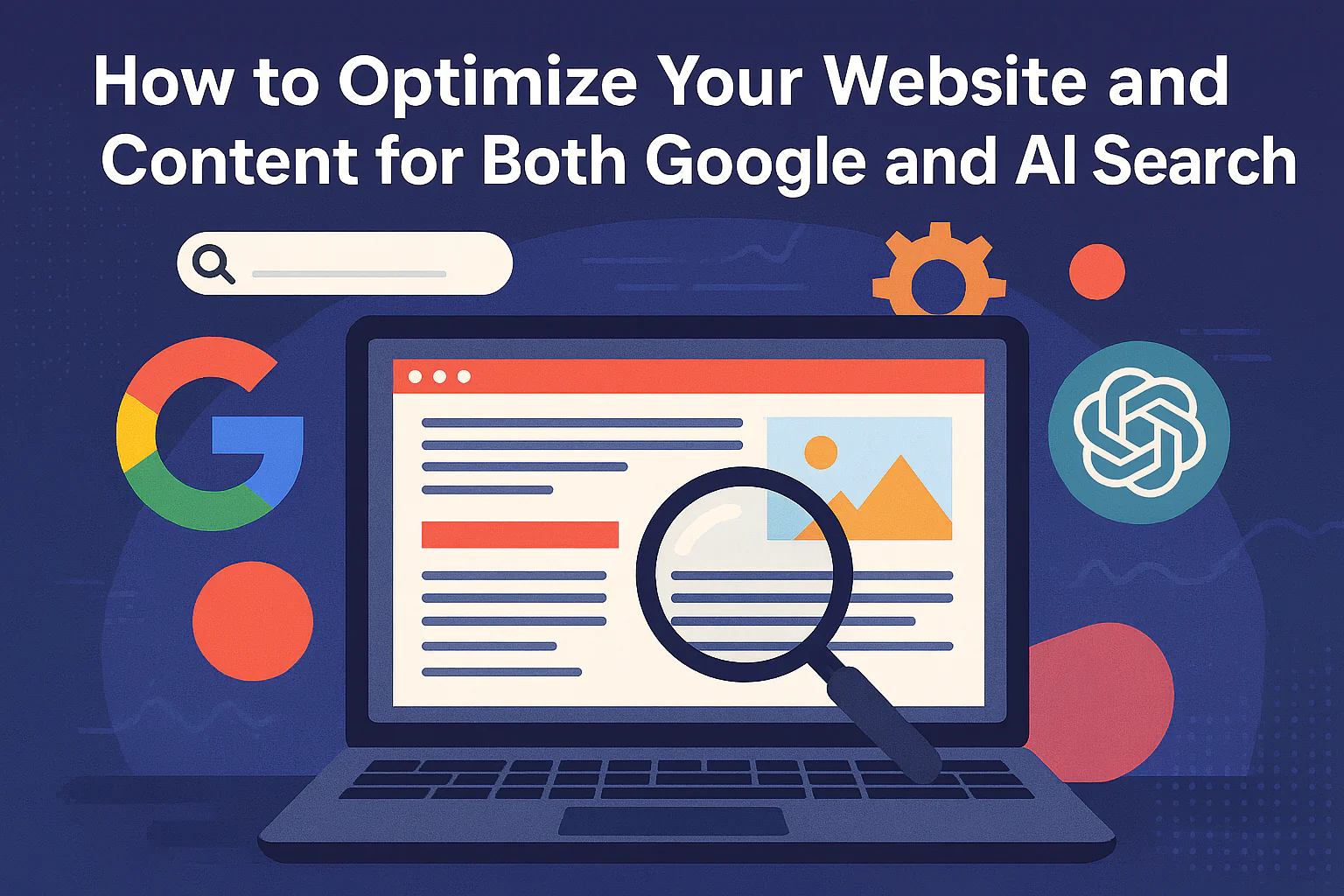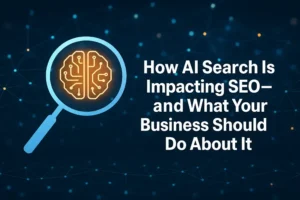✅ What We’ll Cover in This Article
- Why “just blogging” isn’t enough anymore
- What it takes to show up in both Google and AI search
- 5 ways to structure your content for humans and machines
- Quick wins that improve visibility without a full rebuild
- A simple way to see where your site stands today
Intro: Most Sites Are Invisible Where It Matters
Most websites are still built to rank in Google — but that’s only half the game now.
Buyers are getting their answers from tools like ChatGPT, Perplexity, and other AI search engines before they ever hit your homepage. If your content isn’t showing up there, you’re invisible.
Blogging still matters — a lot. But depending on blog content alone isn’t enough anymore. You need content that’s easy for humans to read and easy for AI to quote.
Doceo Pro Tip: Think of your website like your #1 sales rep — it has to be sharp, structured, and always ready with an answer.
Why This Matters Now
The way buyers find you is changing fast.
- On Google, if you’re not on Page 1, you’re not in the conversation.
- In AI tools, if your content isn’t answer-ready, it won’t show up at all.
And if you’re wondering whether AI-generated answers actually influence decisions:
🧠 85% of B2B buyers now use tools like ChatGPT to supplement or replace traditional search.
(Source: Perplexity Blog – 2025)
The good news? You don’t need to rewrite your entire site.
You just need to restructure what you already know — and make it easier to find, cite, and trust.
What’s the Difference: Google SEO vs AI Search?
| Google SEO | AI Search (ChatGPT, Perplexity, etc.) | |
|---|---|---|
| Audience | Humans using search engines | AI summarizing answers for humans |
| Goal | Show up on Page 1 — ideally in the local 3-pack or featured snippet | Be cited or summarized in an AI-generated reply |
| Key Format | Full pages with keywords, internal links, and metadata | Concise, structured answers with plain language |
| Tech Focus | Crawling, indexing, link authority | Semantic reading, answer extraction, structure |
| What Wins | Authoritativeness, internal linking, structured content | Clarity, formatting, schema, and relevance |
5 Ways to Optimize for Both Google and AI Search
1. Use Question-Based H2s and H3s
Why? AI tools (and Google snippets) scan for questions and direct answers.
✅ Do this:
- Use real buyer questions as subheadsExample: “What does a Managed IT provider actually handle?”
- Follow with a short, clear answer (2–4 sentences)
- Add a bullet list, scenario, or example to clarify
📌 This is the core of the They Ask, You Answer approach — and it works.
2. Add an FAQ Block to Every Key Page
Why? Google uses FAQ schema for rich snippets. AI tools use FAQs to extract clean answers.
- Add 3–5 real questions from client conversations
- Use a clear Q+A format (not fluffy paragraphs)
- Mark up with
FAQPageschema
| Doceo Pro Tip: Not sure which questions to include? Start with the ones you’re already answering in sales calls. Or pull from the [Doceo FAQ Bank] for ready-to-paste copy.
3. Write in Plain English and Define Acronyms
Why? AI tools reward clarity. So do buyers.
✅ Best practices:
- Avoid jargon and marketing filler
- Define terms the first timeExample: “MFA (Multi-Factor Authentication)”
- Use short paragraphs and vary rhythm
🛑 Don’t say:
“Our DCA-enabled MPS platform leverages telemetry for proactive uptime.”
✅ Instead:
“We monitor your printers remotely and send toner before it runs out—so work doesn’t stop.”
4. Add Internal Links with Descriptive Anchor Text
Why? Google uses internal links to build context. AI tools use them to understand relationships between topics.
✅ Good link examples:
- “See the [Managed Print guide]”
- “Request a [security audit checklist]”
- “Explore our [IT Solutions overview]”
❌ Avoid:
- “Click here”
- “Read more”
📌 Use the Internal Link Map to route correctly. If you’re unsure, insert:
TODO: [link to ___]
5. Use the Right Schema and Metadata
Why? Schema markup tells search engines and AI tools what your content is — and why it matters.
✅ For every core blog or service page:
- Meta title: 60 characters max
- Meta description: 150–160 characters
- Schema types:
Article,FAQPage(if applicable)
🛠 Tools like Yoast or RankMath (on WordPress) can auto-generate schema and flag what’s missing.
ROI Snapshot: Small Shifts, Big Impact
| Small Shift | Big Impact |
|---|---|
| Add FAQs to key pages | Show up in featured snippets + Perplexity results |
| Define acronyms and terms | Improves AI readability and user trust |
| Use question-based subheads | Boosts scanability and search visibility |
| Structure meta titles + schema | Google knows what your content is — and why it matters |
FAQ
What kind of content shows up in ChatGPT or Perplexity?
Content with clear questions, short answers, and plain formatting — like bullet lists, FAQs, and internal links. That’s what AI tools scan and cite.
Is blogging still worth it?
Absolutely — when it’s done right. Blogging that answers real questions is still one of the best SEO tools out there. But you need to pair it with structure and clarity if you want to win with AI too.
What should we optimize first?
Start with: Your main service pages High-performing blog posts Any content that answers a buyer-stage question like “What’s included?” or “How does it work?”
What about backlinks?
Still important for Google. But AI tools care more about clarity, trust signals, and formatting than link count alone.
How do I know if AI tools are quoting my content?
Perplexity shows citations directly. You can also search your domain in tools like SparkToro, SearchAtlas, or via Google’s “site:” command to spot mentions.
This Is Just a Snippet of What Our Advisors Can Walk You Through
This article is just a glimpse of the kind of straightforward, real-world guidance our Marketing Services Advisors walk through with clients every day.
At Doceo, our Marketing Services Team lives and breathes this work — from SEO practices and content to full-funnel strategy. Led by our CMO, Jim Haney, our Advisors bring decades of hands-on experience and a proven track record of delivering clear, measurable outcomes — not vanity metrics or buzzwords.
Stop Guessing. Start Ranking Smarter.
Most websites don’t fail because of bad content. They fail because no one sees it.
We’ll show you exactly what’s working, what’s missing, and how to fix it — fast.
🔍 Request a complimentary SEO consultation and get AI-ready in your next sprint.
Click Here to Get Started: 👉 Let's Talk





